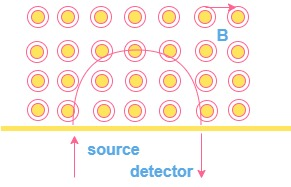
A uniform magnetic field with a slit system shown in fig. is to be used as a momentum filter for high energy charged particles. With a field B tesla, it is found that the filter transmits $ \alpha $ -particles each of energy $ 5\cdot 3 $ MeV. The magnetic field is increased to $ 2\cdot 3 $ B Tesla and deuterons are passed into the filter. The energy of each deuteron transmitted by the filter is…
(A) 5MeV
(B) 7MeV
(C) 14MeV
(D) 21MeV


Answer
539.4k+ views
Hint : The centripetal force required by the ion to move in a circular path is provided by the perpendicular magnetic field B.
$ qvB=\dfrac{m{{v}^{2}}}{r} $
m is mass of charge particle to be accelerated, B is magnetic field, q is charge on particle, v is velocity of charge particle, r is radius of circular path.
The energy of particle is given $ E=\dfrac{{{p}^{2}}}{2m} $
p is the momentum of a particle.
Using the above formulas we will get the required result.
Complete step by step solution:
We have given, high energy charge particle in the magnetic field B Tesla.
Radius of charge particle is given by,
$ \begin{align}
& r=\dfrac{mv}{qB}=\dfrac{P}{qB} \\
& \therefore r=\dfrac{\sqrt{2Em}}{Bq} \\
\end{align} $
Radius in case of $ \alpha $ -particles
$ {{r}_{\alpha }}=\dfrac{{{\sqrt{2{{E}_{\alpha }}m}}_{\alpha }}}{B{{q}_{\alpha }}} $
Radius in case of deuteron –particle is given by
$ {{r}_{d}}=\dfrac{{{\sqrt{2{{E}_{d}}m}}_{d}}}{2.3B{{q}_{d}}} $
Since the radius for both the particle is same
$ \dfrac{{{\sqrt{2{{E}_{\alpha }}m}}_{\alpha }}}{B{{q}_{\alpha }}}=\dfrac{{{\sqrt{2{{E}_{d}}m}}_{d}}}{2\cdot 3B{{q}_{d}}} $
Squaring on both sides
$ \dfrac{2{{E}_{\alpha }}{{m}_{\alpha }}}{{{q}_{\alpha }}^{2}}=\dfrac{2{{E}_{d}}{{m}_{d}}}{{{\left( 2\cdot 3 \right)}^{2}}{{q}_{d}}^{2}} $ ---- (1)
Since,
$ \dfrac{{{q}_{d}}}{{{q}_{\alpha }}}=\dfrac{e}{2e}=\dfrac{1}{2} $
qd is charge on deuteron, $ {{q}_{\alpha }} $ is charge on $ \alpha $ -particle
$ \dfrac{{{m}_{\alpha }}}{{{m}_{d}}}=\dfrac{4}{2}=2 $
$ {{m}_{\alpha }} $ is mass of $ \alpha $ -particle, $ {{m}_{d}} $ is mass of deuteron
$ {{E}_{\alpha }} $ (energy of $ \alpha $ -particle = 5.3 MeV
Put all in eq. (1)
$ \begin{align}
& {{\left( 2.3 \right)}^{2}}\times {{\left( \dfrac{{{q}_{d}}}{{{q}_{\alpha }}} \right)}^{2}}\dfrac{{{E}_{\alpha }}{{m}_{\alpha }}}{{{m}_{d}}}={{E}_{d}} \\
& {{\left( 2.3 \right)}^{2}}\times {{\left( \dfrac{1}{2} \right)}^{2}}\times 5.3MeV(2)={{E}_{d}} \\
\end{align} $
Energy of deuteron particle is given by,
$ \begin{align}
& {{E}_{d}}={{\dfrac{\left( 2.3 \right)}{4}}^{2}}\times 2\times 5.3MeV \\
& {{E}_{d}}=14.01MeV \\
\end{align} $ .
Note:
Motion of charge particle in magnetic field explained below:
Then the centripetal force acquired by charged particle to move in circular path is provided by perpendicular magnetic field B is given by
$ {{F}_{e}}=\dfrac{m{{v}^{2}}}{r} $ --- (1)
$ {{F}_{b}}=qvB $ --- (2)
From eq (1) and (2)
$ \begin{align}
& \dfrac{m{{v}^{2}}}{r}=qvB \\
& \dfrac{mv}{r}=Bq \\
\end{align} $
$ r=\dfrac{mv}{qB} $ This is the radius of circular path.
The momentum of particle is given
$ P=mv $
And energy of particle is,
$ E=\dfrac{{{P}^{2}}}{2m} $
Or
$ P=\sqrt{2mE} $ ,
Radius of charge particle is given by
$ \begin{align}
& r=\dfrac{mv}{qB}=\dfrac{P}{qB} \\
& \therefore r=\dfrac{\sqrt{2Em}}{Bq} \\
\end{align} $.
$ qvB=\dfrac{m{{v}^{2}}}{r} $
m is mass of charge particle to be accelerated, B is magnetic field, q is charge on particle, v is velocity of charge particle, r is radius of circular path.
The energy of particle is given $ E=\dfrac{{{p}^{2}}}{2m} $
p is the momentum of a particle.
Using the above formulas we will get the required result.
Complete step by step solution:
We have given, high energy charge particle in the magnetic field B Tesla.
Radius of charge particle is given by,
$ \begin{align}
& r=\dfrac{mv}{qB}=\dfrac{P}{qB} \\
& \therefore r=\dfrac{\sqrt{2Em}}{Bq} \\
\end{align} $
Radius in case of $ \alpha $ -particles
$ {{r}_{\alpha }}=\dfrac{{{\sqrt{2{{E}_{\alpha }}m}}_{\alpha }}}{B{{q}_{\alpha }}} $
Radius in case of deuteron –particle is given by
$ {{r}_{d}}=\dfrac{{{\sqrt{2{{E}_{d}}m}}_{d}}}{2.3B{{q}_{d}}} $
Since the radius for both the particle is same
$ \dfrac{{{\sqrt{2{{E}_{\alpha }}m}}_{\alpha }}}{B{{q}_{\alpha }}}=\dfrac{{{\sqrt{2{{E}_{d}}m}}_{d}}}{2\cdot 3B{{q}_{d}}} $
Squaring on both sides
$ \dfrac{2{{E}_{\alpha }}{{m}_{\alpha }}}{{{q}_{\alpha }}^{2}}=\dfrac{2{{E}_{d}}{{m}_{d}}}{{{\left( 2\cdot 3 \right)}^{2}}{{q}_{d}}^{2}} $ ---- (1)
Since,
$ \dfrac{{{q}_{d}}}{{{q}_{\alpha }}}=\dfrac{e}{2e}=\dfrac{1}{2} $
qd is charge on deuteron, $ {{q}_{\alpha }} $ is charge on $ \alpha $ -particle
$ \dfrac{{{m}_{\alpha }}}{{{m}_{d}}}=\dfrac{4}{2}=2 $
$ {{m}_{\alpha }} $ is mass of $ \alpha $ -particle, $ {{m}_{d}} $ is mass of deuteron
$ {{E}_{\alpha }} $ (energy of $ \alpha $ -particle = 5.3 MeV
Put all in eq. (1)
$ \begin{align}
& {{\left( 2.3 \right)}^{2}}\times {{\left( \dfrac{{{q}_{d}}}{{{q}_{\alpha }}} \right)}^{2}}\dfrac{{{E}_{\alpha }}{{m}_{\alpha }}}{{{m}_{d}}}={{E}_{d}} \\
& {{\left( 2.3 \right)}^{2}}\times {{\left( \dfrac{1}{2} \right)}^{2}}\times 5.3MeV(2)={{E}_{d}} \\
\end{align} $
Energy of deuteron particle is given by,
$ \begin{align}
& {{E}_{d}}={{\dfrac{\left( 2.3 \right)}{4}}^{2}}\times 2\times 5.3MeV \\
& {{E}_{d}}=14.01MeV \\
\end{align} $ .
Note:
Motion of charge particle in magnetic field explained below:
Then the centripetal force acquired by charged particle to move in circular path is provided by perpendicular magnetic field B is given by
$ {{F}_{e}}=\dfrac{m{{v}^{2}}}{r} $ --- (1)
$ {{F}_{b}}=qvB $ --- (2)
From eq (1) and (2)
$ \begin{align}
& \dfrac{m{{v}^{2}}}{r}=qvB \\
& \dfrac{mv}{r}=Bq \\
\end{align} $
$ r=\dfrac{mv}{qB} $ This is the radius of circular path.
The momentum of particle is given
$ P=mv $
And energy of particle is,
$ E=\dfrac{{{P}^{2}}}{2m} $
Or
$ P=\sqrt{2mE} $ ,
Radius of charge particle is given by
$ \begin{align}
& r=\dfrac{mv}{qB}=\dfrac{P}{qB} \\
& \therefore r=\dfrac{\sqrt{2Em}}{Bq} \\
\end{align} $.
Recently Updated Pages
Master Class 12 English: Engaging Questions & Answers for Success

Master Class 12 Business Studies: Engaging Questions & Answers for Success

Master Class 12 Economics: Engaging Questions & Answers for Success

Master Class 12 Social Science: Engaging Questions & Answers for Success

Master Class 12 Maths: Engaging Questions & Answers for Success

Master Class 12 Chemistry: Engaging Questions & Answers for Success

Trending doubts
Draw a labelled sketch of the human eye class 12 physics CBSE

Explain sex determination in humans with line diag class 12 biology CBSE

The pH of the pancreatic juice is A 64 B 86 C 120 D class 12 biology CBSE

Explain sex determination in humans with the help of class 12 biology CBSE

Differentiate between homogeneous and heterogeneous class 12 chemistry CBSE

Which state in India is known as the Granary of India class 12 social science CBSE




